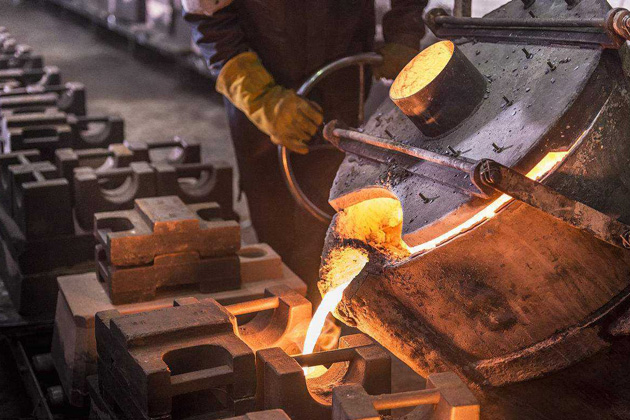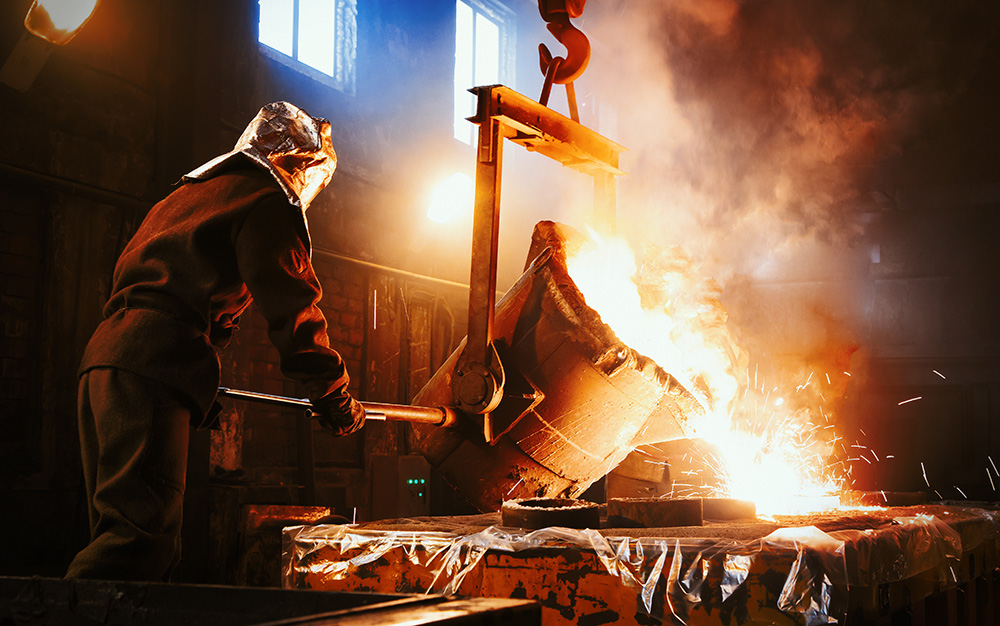Revealing the Intricacies of Design and Manufacturing at a Metal Foundry
The layout and production processes at a metal foundry entail a collection of complex steps. Each stage, from choosing basic materials to melting and casting, plays a critical role in the end product. Aluminum Casting. Accuracy and quality assurance are extremely important in this sector. As innovation breakthroughs, new innovations are arising. These growths may redefine conventional techniques. What ramifications do these adjustments hold for the future of metal factories?
The Melting Process: Transforming Raw Materials Into Liquid Metal
The melting process acts as the critical very first step in transforming basic materials into fluid metal, a treatment crucial for foundry operations. This phase begins with the mindful choice of metals, which might include light weight aluminum, copper, or iron, relying on the wanted last item. Each material is examined for pureness and composition to ensure optimal melting conditions.

As the metals reach their melting factor, they convert from strong to liquid, permitting more refinement. This procedure can likewise consist of the elimination of contaminations with slag formation, guaranteeing the high quality of the fluid steel. Ultimately, the effective completion of the melting procedure lays the structure for succeeding metalworking operations.
Molding Methods: Forming Metal With Precision
Adhering to the melting procedure, the next stage in metal foundry procedures involves molding methods that shape the liquid steel into preferred types. Numerous approaches are used, each picked based on the certain requirements of the job. Sand casting, one of one of the most typical strategies, uses a combination of sand and binder to develop molds that can be easily formed and reused. Another technique, investment casting, involves creating a wax pattern that is coated in a ceramic covering, allowing for elaborate layouts and high accuracy.
Pass away casting, in comparison, utilizes high-pressure to infuse liquified steel right into steel mold and mildews, causing consistent and resilient products. Additionally, the choice of molding method impacts the cooling price, surface area coating, and dimensional precision of the end product. Recognizing these strategies is vital for maximizing design and ensuring the successful manufacturing of steel parts customized to specific applications.
Casting Techniques: From Prototype to Production
Countless casting methods are utilized in metal factories to move from model growth to full-blown production. Among these techniques, sand casting stands out for its versatility and cost-effectiveness, making it optimal for both little and large production runs. Investment casting, understood for its precision, is commonly used for intricate geometries, permitting great details in the last item. Die spreading, ideal for high-volume production, utilizes molten steel infused right into mold and mildews, giving excellent surface coating and dimensional accuracy.

Quality Assurance: Guaranteeing Quality in Every Pour
While the spreading procedure can differ substantially between techniques, keeping strenuous top quality control is important to determine that every pour satisfies the called for criteria. Quality assurance in a metal foundry includes a series of organized Get the facts checks and examinations created to determine flaws early in the manufacturing process. This consists of careful assessments of raw products, surveillance of melting temperatures, and analyses of mold and mildew honesty.
Foundry employees use different testing techniques, such as non-destructive screening and dimensional confirmation, to identify that castings attain wanted specs. In addition, adherence to established market criteria and certifications enhances the dependability of the end product.
Responses loops are likewise crucial; any kind of disparities kept in mind during high quality analyses are assessed to fine-tune procedures and minimize future mistakes. Ultimately, a culture of quality control cultivates not only consumer complete satisfaction however also a track record for excellence in the affordable landscape of steel production.
Technologies and Technologies: The Future of Metal Foundries
The landscape of steel factories is swiftly evolving, driven by advancements in technology and innovative methods. Automation and robotics are changing conventional process, boosting performance and accuracy throughout production. Automated pouring systems and robotic arms reduce human error, leading to better results. Additionally, the integration of expert system is allowing predictive upkeep, maximizing equipment efficiency, and lessening downtime.
Additive production is arising as a game-changer, permitting rapid prototyping and the development of intricate geometries that were previously unattainable. This modern technology helps with the customization of steel parts, accommodating particular customer demands without substantial time delays.
Sustainability is also a vital emphasis, with shops embracing greener techniques, such as reusing scrap steel and making use of energy-efficient furnaces. These advancements not just improve productivity however additionally straighten with worldwide initiatives towards environmentally responsible manufacturing, making certain the future of steel factories continues to be robust and competitive in an altering commercial landscape.
Often Asked Inquiries
What Sorts of Metals Are Commonly Made Use Of in Shops?
Common metals utilized in shops consist of aluminum, cast iron, bronze, steel, and brass (Aluminum Foundry). Each metal possesses distinct buildings, making them a knockout post appropriate for numerous applications in industries such as vehicle, aerospace, and construction, to name a few
Just How Do Foundries Handle Waste and Environmental Impact?
Foundries manage waste and environmental effect by executing recycling programs, using innovative filtering systems, and sticking to stringent governing criteria. They typically spend in lasting technologies to minimize exhausts and promote accountable resource use throughout their operations.
What Security Steps Are in Place for Employees?
Foundries execute different precaution for workers, consisting of individual safety tools, appropriate air flow systems, regular security training, emergency response methods, and strict adherence to occupational health and wellness policies to lessen risks related to unsafe materials and equipment.
The length of time Does the Entire Manufacturing Process Normally Take?
The whole manufacturing procedure usually takes a number of weeks, depending visit this website upon the intricacy of the style and the products used. Variables such as mold preparation, melting, and cooling time considerably influence the overall period of production.
What Are the Key Tests Faced by Metal Shops Today?
Metal foundries today encounter challenges such as rising material expenses, rising and fall demand, environmental guidelines, proficient labor lacks, and preserving quality assurance. These problems make complex production performance and earnings in a significantly open market.
The layout and production procedures at a metal foundry include a series of detailed actions. The melting process offers as the essential first action in transforming raw products into fluid metal, a procedure important for foundry procedures. Adhering to the melting process, the following stage in metal foundry procedures involves molding methods that form the liquid steel right into desired types. Many spreading techniques are used in metal foundries to shift from prototype development to full-scale manufacturing. Quality control in a metal foundry encompasses a collection of organized checks and assessments created to recognize issues early in the production process.